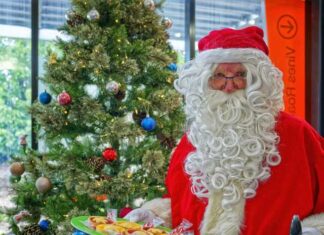 Packing ‘em in: Natasha Clark with one of her Surf Coast property’s 500 alpaca’s. Picture: Tommy Ritchie 60130
Packing ‘em in: Natasha Clark with one of her Surf Coast property’s 500 alpaca’s. Picture: Tommy Ritchie 60130
Andrew Mathieson
WHEN Ann and Natasha Clark switched livestock on their property from horses to alpacas the last thing on their mind was the sniggers from the other side of the fence.
One of Victoria’s first alpaca breeders back in 1990, the Bellbrae mother and daughter were still coming to terms with domesticating the unique animal that resembled something between a sheep and a camel.
“The worse thing was trying to find shearers in those days because nobody knew how to shear them,” Ann confesses.
“Sheep shearers first didn’t know how to tackle alpacas, so there was a few who worked out some good ways because you can’t put a great big, long-neck, long-legged thing sitting up like a sheep.
“So we actually found out we had to tie them down.”
Worse still for naive shearers back then was alpacas disliked being touched on their heads, feet, legs and abdomen, making their job even tougher.
While herds of alpacas strolling the mountains of Peru, Ecuador and Bolivia are just a part of scenery, they live on very few Australian farms amid onlookers’ fleeting glances and curious questions.
Most are related to confusing shouts of llamas: the bigger, pack and meat animals from the same camelid family.
No one else would know the difference the two better than the 39-year-old Natasha, who in 2004 travelled to the Peruvian school to gain her Australian international alpaca judge qualification.
“My eyes were popping out of my head,” Natasha
“You go places and see just alpacas walking the paddocks and mountains everywhere.”
Alpacas have historically been bred for their abundance of soft, lustrous fleece, but the Clarks have done pretty well from stud breeding on their Kurrawa named property.
The one-time “weekend farmers” surrendered seven hectares in Melbourne’s far east full of horses and a few ponies for more than 52 empty hectares on the Surf Coast.
Ann’s family had always bred horses over several generations until husband Bob instigated the change on their seachange move.
“Bob wanted something that he could relate to rather than horses that he wasn’t too keen on,” Ann recalls.
“So we looked into all sorts of livestock, including ostriches that he thought looked alright.
“I said that was okay for him, but we’d be home to look after them and I didn’t fancy looking eyeball to kneecap to this bird.”
When Bob bought a Town and Country magazine one time, they found out about Geelong’s first-ever, but little-known alpaca stud.
A quick visit one night resulted in the family bringing home three young alpacas, which two decades later has now bred to nearly 500.
“We had never seen them before then and we just loved them,” Ann says.
Despite their sheep like characteristics, hundreds of their alpacas are given personal names unlike sheep scattered among the flock.
Natasha can boastfully name three-quarters in full fleece until they are shorn.
So when some of the alpacas live for 20 years, they become a part of a family rather than just stock.
“We certainly have favourites,” Natasha adds.
“There are ones who have got really good personalities and follow you around the paddocks.
“So you just can’t help it to like them.”
Buried among the thousands of ribbons from national titles and countless royal shows each year, Ann points to a favourite photo that takes pride of place in their loungeroom.
Their only national supreme champion in 2009, Ann explains how Tariq was the chosen one.
“We picked him out at two days old,” she reveals.
“We saw him and were like ‘wow, just look at him’.
“He was just an absolute standout.”
As breeders, the Clarks have had suri champions – the “dreadlocked” of two alpaca breeds – in every age and category.
But even champions have limits.
For their best 14 alpacas stuck in a van and horse floats, a trip to Tamworth for last year’s national show was memorable for the wrong reasons.
“What a trip,” Ann grins.
“It took us two long days to get there.
“We had to stop and get carpet because they kept weeing all over the floor after we packed in shredded paper.”






